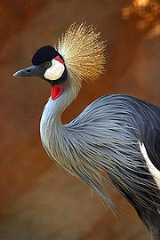
Balearica
Encyclopedia
The bird
genus Balearica consists of two species in the crane
family Gruidae: the Black Crowned Crane
(B. pavonina) and the Grey Crowned Crane
(B. regulorum).
The species today occur only in Africa
, south of the Sahara Desert, and are the only cranes that can nest in trees. This habitat is one reason why the relatively small Balearica cranes are believed to closely resemble the ancestral members of the Gruidae.
Like all cranes, they eat insect
s, reptile
s, and small mammal
s.
and adjacent regions, the present genus appears to have had a more Atlantic distribution, ranging into Europe and North America; it is not known from the fossil record of Asia.
Bird
Birds are feathered, winged, bipedal, endothermic , egg-laying, vertebrate animals. Around 10,000 living species and 188 families makes them the most speciose class of tetrapod vertebrates. They inhabit ecosystems across the globe, from the Arctic to the Antarctic. Extant birds range in size from...
genus Balearica consists of two species in the crane
Crane (bird)
Cranes are a family, Gruidae, of large, long-legged and long-necked birds in the order Gruiformes. There are fifteen species of crane in four genera. Unlike the similar-looking but unrelated herons, cranes fly with necks outstretched, not pulled back...
family Gruidae: the Black Crowned Crane
Black Crowned Crane
The Black Crowned Crane is a bird in the crane family Gruidae. It was once called also Kaffir Crane.It occurs in dry savannah in Africa south of the Sahara, although in nests in somewhat wetter habitats. There are two subspecies: B. p. pavonina in the west and the more numerous B. p...
(B. pavonina) and the Grey Crowned Crane
Grey Crowned Crane
The Grey Crowned Crane is a bird in the crane family Gruidae. It occurs in dry savannah in Africa south of the Sahara, although it nests in somewhat wetter habitats. This animal does not migrate....
(B. regulorum).
The species today occur only in Africa
Africa
Africa is the world's second largest and second most populous continent, after Asia. At about 30.2 million km² including adjacent islands, it covers 6% of the Earth's total surface area and 20.4% of the total land area...
, south of the Sahara Desert, and are the only cranes that can nest in trees. This habitat is one reason why the relatively small Balearica cranes are believed to closely resemble the ancestral members of the Gruidae.
Like all cranes, they eat insect
Insect
Insects are a class of living creatures within the arthropods that have a chitinous exoskeleton, a three-part body , three pairs of jointed legs, compound eyes, and two antennae...
s, reptile
Reptile
Reptiles are members of a class of air-breathing, ectothermic vertebrates which are characterized by laying shelled eggs , and having skin covered in scales and/or scutes. They are tetrapods, either having four limbs or being descended from four-limbed ancestors...
s, and small mammal
Mammal
Mammals are members of a class of air-breathing vertebrate animals characterised by the possession of endothermy, hair, three middle ear bones, and mammary glands functional in mothers with young...
s.
Fossil record
Crowned cranes seem to have been more widespread prehistorically. Compared to the true cranes, genus Grus, which were always common in the HolarcticHolarctic
The Holarctic ecozone refers to the habitats found throughout the northern continents of the world as a whole. This region is divided into the Palearctic, consisting of Northern Africa and all of Eurasia, with the exception of Southeast Asia and the Indian subcontinent, and the Nearctic,...
and adjacent regions, the present genus appears to have had a more Atlantic distribution, ranging into Europe and North America; it is not known from the fossil record of Asia.
- Balearica rummeli (Early Miocene of Germany) – formerly Basityto
- Balearica excelsa (Early–Middle Miocene of France) – formerly Grus and Ornithocnemus
- Balearica exigua (Miocene of Nebraska)

